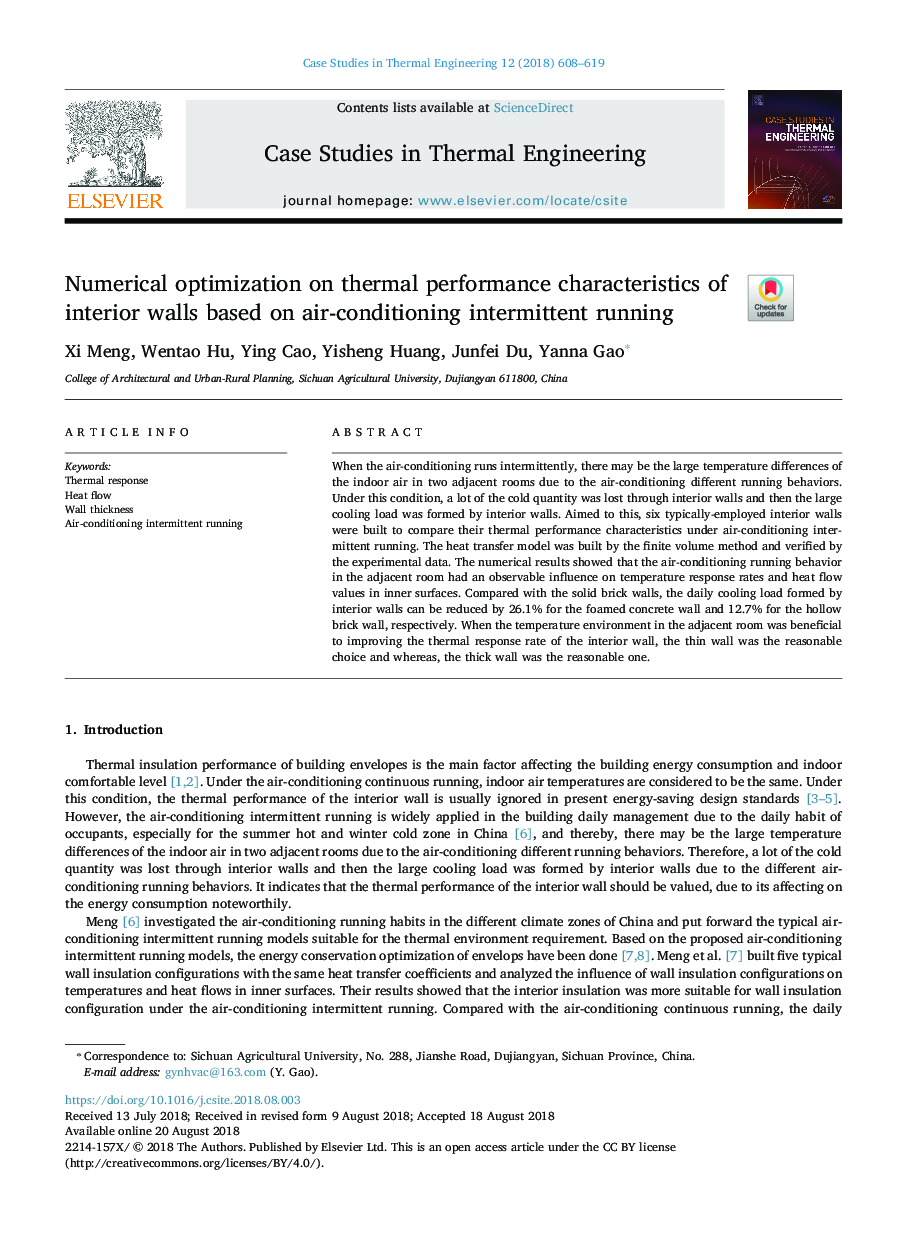| کد مقاله | کد نشریه | سال انتشار | مقاله انگلیسی | نسخه تمام متن |
|---|---|---|---|---|
| 11003728 | 1462473 | 2018 | 12 صفحه PDF | دانلود رایگان |
عنوان انگلیسی مقاله ISI
Numerical optimization on thermal performance characteristics of interior walls based on air-conditioning intermittent running
ترجمه فارسی عنوان
بهینه سازی عددی در ویژگی های عملکرد حرارتی دیوارهای داخلی بر اساس هوای موقت در حال اجرا متناوب
دانلود مقاله + سفارش ترجمه
دانلود مقاله ISI انگلیسی
رایگان برای ایرانیان
کلمات کلیدی
پاسخ گرمایی، جریان دما، ضخامت دیوار، تهویه مطبوع در حال اجرا متناوب،
ترجمه چکیده
هنگامی که تهویه مطبوع به طور متناوب اجرا می شود، به علت رفتارهای مختلف در حال اجرا در تهویه مطبوع، اختلاف دمای هوا در دو اتاق مجاور ممکن است متفاوت باشد. تحت این شرایط، مقدار زیادی از مقدار سرد از طریق دیواره های داخلی از بین رفت و سپس بار خنک کننده بزرگ توسط دیواره های داخلی تشکیل شده است. به منظور انجام این کار، شش دیوار داخلی به طور معمول کار می کردند تا ویژگی های حرارتی خود را تحت شرایط متداول تهویه مطبوع مقایسه کنند. مدل انتقال حرارت توسط روش حجم محدود ساخته شده و با داده های تجربی تأیید شده است. نتایج عددی نشان داد که رفتار در حال اجرا در تهویه مطبوع در اتاق مجاور تأثیر قابل توجهی بر میزان پاسخ و درجه حرارت گرما در سطوح داخلی داشته است. در مقایسه با دیوارهای آجری جامد، بار خنک کننده روزانه دیوارهای داخلی می تواند به میزان 1/26 درصد برای دیوار بتنی فوم و 7/12 درصد دیوار آجری توخالی کاهش یابد. هنگامی که محیط محیطی در اتاق مجاور برای بهبود میزان پاسخ حرارتی دیوار داخلی مفید بود، دیوار نازک انتخاب مناسب بود و در حالی که دیوار ضخیم منطقی بود.
موضوعات مرتبط
مهندسی و علوم پایه
سایر رشته های مهندسی
مهندسی مکانیک
چکیده انگلیسی
When the air-conditioning runs intermittently, there may be the large temperature differences of the indoor air in two adjacent rooms due to the air-conditioning different running behaviors. Under this condition, a lot of the cold quantity was lost through interior walls and then the large cooling load was formed by interior walls. Aimed to this, six typically-employed interior walls were built to compare their thermal performance characteristics under air-conditioning intermittent running. The heat transfer model was built by the finite volume method and verified by the experimental data. The numerical results showed that the air-conditioning running behavior in the adjacent room had an observable influence on temperature response rates and heat flow values in inner surfaces. Compared with the solid brick walls, the daily cooling load formed by interior walls can be reduced by 26.1% for the foamed concrete wall and 12.7% for the hollow brick wall, respectively. When the temperature environment in the adjacent room was beneficial to improving the thermal response rate of the interior wall, the thin wall was the reasonable choice and whereas, the thick wall was the reasonable one.
ناشر
Database: Elsevier - ScienceDirect (ساینس دایرکت)
Journal: Case Studies in Thermal Engineering - Volume 12, September 2018, Pages 608-619
Journal: Case Studies in Thermal Engineering - Volume 12, September 2018, Pages 608-619
نویسندگان
Xi Meng, Wentao Hu, Ying Cao, Yisheng Huang, Junfei Du, Yanna Gao,
